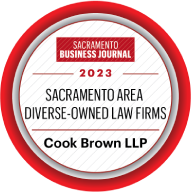Poorly drafted handbooks can run afoul of the National Labor Relations Act when they overstep certain employee rights. Steve McCutcheon looks at the case of In-and-Out Burger and the “Fight for $15” button.
Transcript
Hello, I am Steve McCutcheon, welcome to the Cook Brown labor and employment law podcast. Cook Brown is a California law firm representing public and private sector employers in labor and employment matters involving everything from routine advice to complex class action litigation.
Today I am going to be talking about employee handbooks, and although handbooks are a mundane topic this is an area where employers can unintentionally violate the National Labor Relations Act (NLRA). The NLRA applies to both union and non-union companies alike, and many of the National Labor Relations Board’s recent decisions have involved non-union companies.
Before we get started, I have to remind you that this podcast is for informational purposes only. It doesn’t create an attorney-client relationship between Cook Brown and the listener, should not be treated as legal advice. It is important that you consult a local attorney for specific advice applicable to your company and tailored to your needs.
Employee handbooks are often treated as a formality by employers, something that was drafted many years ago, is handed out to new employees, and then dropped back into the filing cabinet. Your employee handbook is more important than that, and communicates to your workers your policies expectations on everything from meal and rest breaks, sick leave, confidentiality of customer information and creating a workplace free from discrimination and harassment.
The problem is that policies that everyone would agree are worthwhile in principle, can violate the NLRA if they are drafted poorly or enforced improperly. The NLRA protects the right of employees to band together for mutual aid and protection, and if a policy can be construed in a way that restricts or discourages this activity, the employer may be found in violation of the NLRA. It does not matter if the employer has never interpreted the policy that way, it is not the most natural reading of the policy, or has never enforced it in a way that would violate the NLRA.
For example, we all recognize that a company’s image and customer service are very important. Most people would think that an employer could have a policy requiring employees to represent their employer in the community in a positive and professional manner would be permissible. Or that you could have a policy prohibiting negativity and gossip in the workplace to avoid squabbles and personality conflicts. These types of policies have been struck down by the NLRB as they could be construed to prohibit employees from speaking out publicly or among themselves about the terms and conditions of their employment, or ban criticism of supervisors. The policies may further legitimate customer service and workplace civility interests, but are overbroad.
Along these same lines, uniform policies and dress codes promote a company’s image, but depending upon how they are enforced, these dress codes can violate the law. Anyone who has visited an In-N-Out burger for a double-double, fries, and a chocolate shake will recognize the chain’s distinctive red and white uniform. The NLRB recently decided that In-N-Out’s interest in protecting its clean and consistent image did not justify prohibiting an employee from wearing a “Fight-for-15” button arguing for an increase in the minimum wage. Even though the rule was consistently applied, and was not directed at union activity, the NLRB found it was unlawful because it prohibited or chilled the exercise of employee speech relating to their employment.
Now you might also think that confidentiality policies are clearly OK, but they can also get an employer in trouble if poorly drafted. That highlights the need for employers to have the assistance of counsel when writing their handbook. For example, a rule stating that employees will not discuss “customer or employee information outside of work” will be over broad. Although it addresses legitimate concerns regarding customers, it goes too far in prohibiting employees from talking about their wages, hours, workplace safety, and other issues outside of work.
On the other hand, a policy that focuses on business secrets, confidential information, or confidential information of customers, can be lawful, but have to be drafted in a way that employees and the NLRB will not take them as restricting their ability to talk about the terms and conditions of their employment.
It is not enough that any of these policies, or the handbook in general, include a disclaimer that it is not intended to restrict any rights protected by the NLRA. Contradictory language in elsewhere in the policy or handbook will undercut the disclaimer.
The bottom line is the NLRA applies to all employers, and many non-union employers simply do not have the NLRA in mind when drafting their policies. It is important to make sure that the policies in your handbook are drafted properly, and managers and supervisors are trained on how to implement them to avoid unfair labor practice charges with the NLRB.
Thank you for listening to our podcast. I encourage you to browse through our legal updates and subscribe to our Labor Law Today blog. Thanks again.

